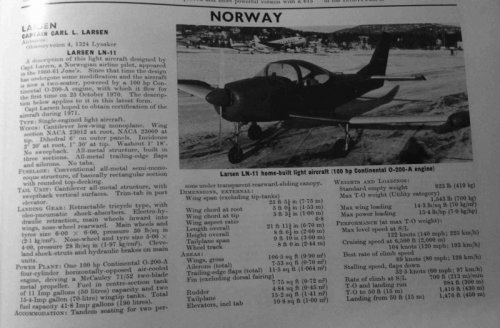I just stumbled upon this thread and I'm most intrigued by the fact that that anyone outside of Norway has ever heard about Larsen, let alone his bizjet project.

Anyway, for those still interested:
Carl Ludvig Larsen, DFC was a Norwegian pilot and for decades a senior captain for the airline Braathens S.A.F.E. Like many other young men of his generation, he went to sea and eventually jumped ship and joined the Norwegian air force training center in Toronto after war broke out, but only after about one year of convoy service. In Norway, he's known as "Bombe-Larsen", a nickname he earned while serving as an aircraft commander with 76 sqn RAF. After the war, he was one of the first pilots to join the new Braathens airline, where he stayed on until retirement.
Always quite the entrepeneur and inventor, Larsen went on to design and build his own single-engine light aircraft, dubbed the "Larsen Special" (mentioned above). The aircraft went through major development throughout its life, and eventually became quite efficient and fast. The range was astonishing compared to other light aircraft at the time, and Larsen is known to have filed Tromsø, Norway (ENTC) as alternate once, while planning a flight (hop?) between Malmö, Sweden and Copenhagen, Denmark. A quick glance at a map surely will reveal the joke. Larsen passed away in 2005, leaving most of his archive to the Norwegian Civil Aviation Museum.
Now, for the business jet project. Larsen reportedly followed the development of light jet engines with great interest, and started playing with the idea of designing and building a 4-6 place jet aircraft by himself. As
elmayerle says, it looks vaguely similar to the Cessna 407, but it was also heavily influenced by the Morane-Saulnier MS.760 Paris, powered by Turbomeca Marboré engines. Indeed, Larsen placed an order for two of the power plants, but it has been said that when his wife learned of this she demanded he buy her jewelry for the same amount as the engines were worth, and the Turbomeca order was cancelled. While a good story, the more plausible reason for the project to be put on ice is that Larsen was out of his depths, without the competence needed to design an advanced aircraft like the C407 or the Paris. We have been trying to find any kind of documentation of what the end result was going to look like, or how it was supposed to perform, but without any success so far. Some people believe that Larsen approached the task in the same way he did with his first design; quite intuitively and without a clear specification.
After Larsen abandoned the project, the unfinished hull was left for kids (like myself) to play with and eventually ended up at the Royal Norwegian Air Force Museum reserve collection (today a great museum in itself) at Oslo Gardermoen airport (OSL/ENGM). It didn’t really fit in there and was almost thrown away, but was saved (again) by some enthusiasts from a flying club up in the mountains. And there it resides to this day, waiting to be brought back to the small museum at the old airport at Fornebu (former FBU/ENFB) were we want to display it to commemorate CL Larsen, but also the local aerospace industry.








